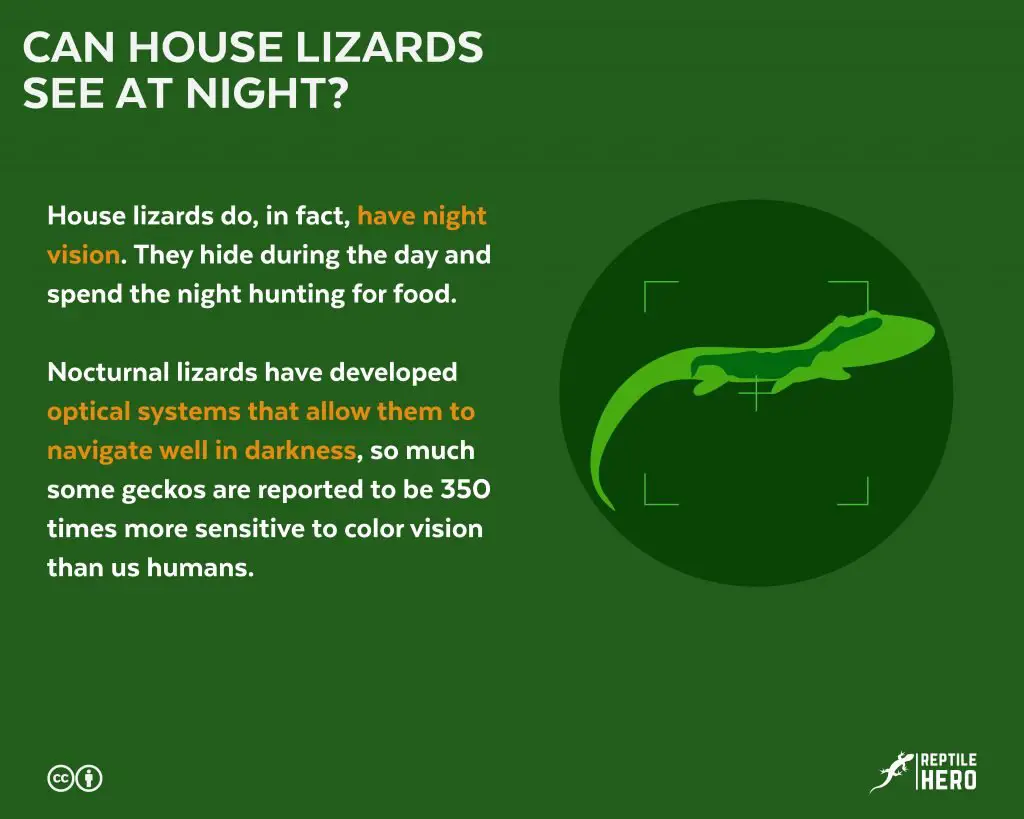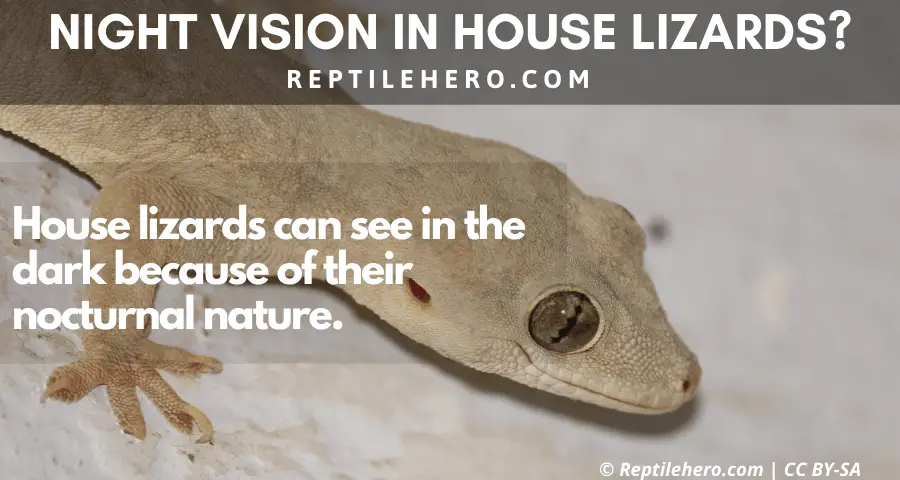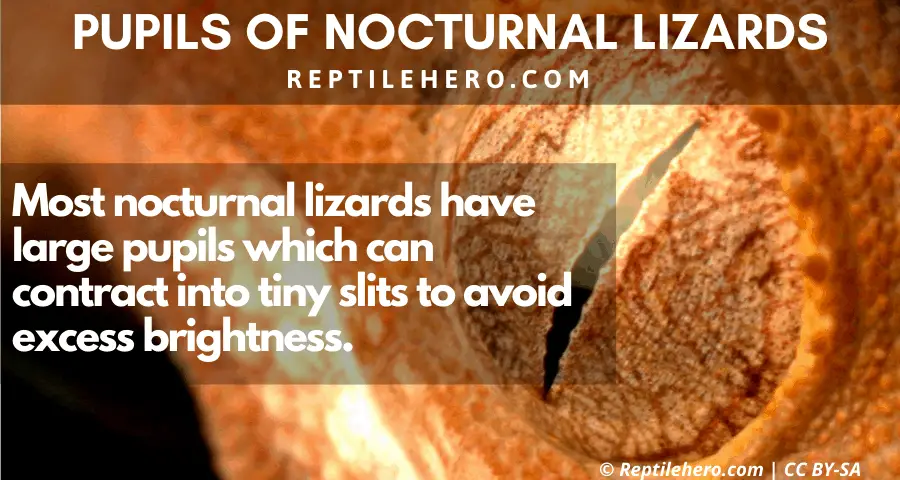Can House Lizards See At Night (Dark)?
When you catch a glimpse of movement, glowing eyes, or even hear a weird clicking noise from your walls during the dark of night, it’s not always because of anything supernatural– most times, it’s just a friendly common house gecko. So this may make you wonder, can these lizards see in the dark? Do they even like the dark?
House lizards do, in fact, have night vision. They hide during the day and spend the night hunting for food. Nocturnal lizards have developed optical systems that allow them to navigate well in darkness, so much some geckos are reported to be 350 times more sensitive to color vision than us humans.

Stick around as we talk more about how these nocturnal lizards came to be the way they are now.
Do House Lizards Have Night Vision?

House lizards developed the ability to see in the dark because they are nocturnal.
To survive predators and better hunt for food, the house lizard learned to schedule its activities to its advantage. During daytime, it would escape larger animals by hiding in foliages, cracks, and corners. When the coast is clearer at night, it would go out and look for prey, especially near the artificial lighting in our houses which can attract swarms of these insects. That many a catch around our light bulbs is good news to any insectivore lizard who decides to hunt during the night. Take it from this mediterranian house gecko right here:
So as the house lizards adapted to this nocturnal behavior, so did their eyes. Their night vision now helps them navigate and survive during their nightly feedings.
To better understand how they succeeded in doing this, let’s first talk about how their eyes work.
How Do Lizard Eyes Work? Based on Science
Nocturnal lizards usually have larger pupils, only constricting them into tiny slits whenever there is excess brightness in the environment they are in. Here is a video capturing this instance in a crested gecko:
This is because nocturnal animals developed bigger eyes and pupils so that they can gather more light even while they stay in darker places. Also, all eyes in general have two types of photoreceptors that absorb this light and allow us to see: rods and cones.
Rods are activated in low levels of light and are those responsible for the way we see things at night or when our surroundings are relatively dim. This is why for us humans, while we cannot tell apart colors well in the dark, we can still somewhat see outlines and be able to tell apart one object from another.
Cones, on the other hand, work when there is more light available. The information we get from these photoreceptors are colors, acuity, and the overall clarity. As humans, our ability to see colors depend on the three types of cones in our eyes: blue, green, and red. Other animals can have fewer or more cones than us and see colors differently.
Based on this, the usual expectation would be that when a creature is diurnal (awake at daytime), it makes sense for them to develop more cones, while nocturnal creatures tend to have more rods. However, most nocturnal lizards broke away from this expectation and instead lost their rods and instead developed bigger, rod-like cones, combining the functions of the two photoreceptors.
Why? Well, I guess we can say that they evolved a little differently.
The Secret To Special Eyes: Evolution

During earlier times, lizards were identified as diurnal in nature. For some species, this resulted in them losing their rods altogether and opting to develop more cones in their retina instead as they spent most of their time in brightness.
But along the way, some of these diurnal lizards decided to switch to more nocturnal lifestyles. Since they no longer have rods, there are lizards that instead developed their existing cones to be bigger and more sensitive to perform rod-like functions. This allowed their eyes to still recognize color and clarity even in low levels of light, thus their night vision.
So now we have our nocturnal friends with night vision and larger eyes. Their larger eyes and pupils, however, usually comes with a trade-off: their vision becomes less focused. This is because as the pupils grow larger, its distance from the retina (also called the focal length) also becomes smaller. This means the more light they get, the more blurry things would get.
Thankfully, nocturnal lizards developed multifocal lenses to counter that. They developed multiple zones in their eyes with different refractive powers, all working together to help them to process images better. Because of this, they got to keep the best of both rods and cones, as well as both large pupils and a focused vision.
Seeing Colors In Darkness
The ability of nocturnal lizards to see colors in low light was demonstrated in a study back in 2004 involving helmet geckos. A group of researchers from Sweden trained these lizards by feeding them crickets using two types of tongs: one labelled blue and one labelled gray. For the crickets fed using the gray tong, they decided to dip it in a salty solution, making it undesirable for the geckos.
As a result, the geckos learned to eat crickets off the blue tong instead and avoid the gray one. Then the team decided to feed these geckos using the same tongs while under dim moonlight. While we as humans may not be able to tell apart the blue tong from the gray, their study showed that these geckos could see the difference between the two. It was also computed that when it comes to color vision, the eyes of these helmet geckos can be 350 times more sensitive than the human eye.
Are All Lizard Eyes The Same?
It may be easy to assume that all lizards share this ability to see in the dark and this specific optical system, but the truth is these animals are more interesting and diverse than we think. Majority of lizards are actually diurnal, including the popular bearded dragon. Meanwhile, there is also a third category: some species like the leopard gecko are crepuscular lizards, making dawn and dusk their active hours.
There are also studies that suggest that some lizards have also evolved to become diurnal again multiple times. Some species also have overlapping waking hours (a nocturnal lizard may still need to have a certain level of vision when they finish hunting at dawn, the same way crepuscular lizards would).
So given how different yet closely related these functions are, drawing the line between nocturnal, diurnal, and crepuscular lizard eyes may become a little more complicated.
But thankfully, studies show that the macroscopic features of these eyes still reveal enough significant insights to each lizard’s nature. Apart from these physical differences, researchers also believe that when it comes to lizards with overlapping activities, changes in their eyes while they are in transition between different dayhours can still be detected through the use of morphometric analysis.
All in all, we can say that nocturnal lizards have a sort of superpower of their own when it comes to night vision. And somehow, the saying “the eyes are the windows to the soul” slightly becomes more meaningful if we think about all the ways we can better understand one’s history and way of life– even if what we’re talking about is the lizard on your wall.
Do Lizards Have A “Third Eye”?
One interesting trivia about lizards is that some species (along with other reptiles belonging to order Rhynchocephalia and order Squamata, suborder Lacertillia) possess an extra eye on top of their head called the parietal eye. While this eye is usually covered by scales as the lizards grow, it is still visible among certain reptiles especially when they are still young. Some known reptiles that have this eye are the tuatara, slow worms, monitor lizards, skinks, lacertids, and select iguanids.
The specific function of this eye is still being studied, and I may dedicate a separate article to better dive into this topic, but studies imply that the parietal eye has a significant relationship to the following:
- The reptile’s pineal gland and its effects on its photosensitivity and serotonin based on its environment (whether they thrive in lower light or not)
- Melatonin production and its behavioral and physiological impacts, including to thermoregulation capabilities
- The reptile’s ability to track the sun and use it to recognize directions and orientations, and
- A potential clue to how color vision evolved from less developed creatures like a spineless scallop to more advanced ones such as us humans
Do All Lizards Sleep?
Yes, lizards sleep! The schedule just depends on their waking hours, just as we discussed above. Sleep is obvious for some lizards, especially for those with eyelids like leopard geckos. But what about crested geckos and other lizards that do not have eyelids at all?
While signs of sleep may not be obvious for these lizards, they still need it. Signs would usually include a slightly lowered pupil (and eyelashes in crested geckos) and a somewhat glazed over looking eye.
Also, even without eyelids their eyes are still protected with a clear membrane called brille. This is a shared trait that they have with snakes, with this layer serving as like a fixed contact lens on their eyes and also being shed regularly with their skin.
It is possible for them to dream as well. While it is acknowledged that sleep is shared by all animals, it was initially believed that only mammals and birds are able to experience rapid eye movement (REM) sleep, which is commonly linked to dreaming. But as it turns out, reptiles experience it too.
One big difference, however, is the duration. Compared to our 60-90 minutes of experiencing this cycle, reptiles spend only 60-90 seconds for them. Still, scientists believe that reptiles sharing this ability for REM sleep may be due to a common ancestor it has with mammals that existed about 350 million years ago.
Takeaways
- House lizards are nocturnal creatures and can see clearly in the dark with their high sensitivity to light and color vision.
- Nocturnal lizards usually have larger pupils to better capture light in darker areas, with these pupils being constricted to thin slits whenever the brightness is increased.
- Larger pupils can give animals blurred vision, but nocturnal lizards developed multifocal lenses to help them capture images clearer.
- Some groups of reptiles, including some lizards, have a “third” or parietal eye that may have significant links to their photosensitivity, thermoregulation, sense of direction, and contribution to color vision.
- Lizards sleep; in fact REM sleep has been observed in reptiles, lasting about 60-90 seconds each cycle.


![Do Geckos and Reptiles Dream in Their Sleep? [What Science Says]](https://www.reptilehero.com/wp-content/uploads/2021/07/Gecko-Sleeping-Infographic-768x614.jpg)

![Gecko Alone While On Vacation? [7 Things To Check]](https://www.reptilehero.com/wp-content/uploads/2022/03/gecko-alone-cc-1-768x614.jpg)
![7 Reasons Why Gecko Feet Are Not Sticky [and 2 Solutions]](https://www.reptilehero.com/wp-content/uploads/2021/03/G37-768x614.jpg)

